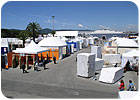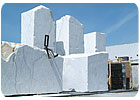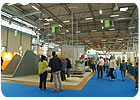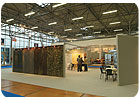
CarraraMarmotec 2008 is set to take place from May 29 to June 1, 2008 in the renowned stoneworking center of Carrara, Italy.
Scheduled for May 29 to June 1, 2008 in the renowned stoneworking center of Carrara, Italy, the CarraraMarmotec exhibition has historically served as a venue to exhibit and see some of the latest introductions in natural stone products as well as stoneworking technology. It has also been a forum where natural stone suppliers can collaborate with architects and designers, and organizers are looking to expand on this aspect of the fair as it adapts to a new biennial format.
“This new look has been understood perfectly by the [exhibiting] companies, and their response is positive,” explained Giorgio Bianchini, Chairman of CarraraFiere. “Both technology companies and natural stone groups are backing the new style of exhibition, which aims to promote the modernization of the industry and the ‘Made in Italy’ brand.”
A scientific board composed of professionals, architects, designers, journalists and scholars will be supporting CarraraMarmotec in this innovation. Additionally, they will identify the issues to be discussed at the exhibition on a regular basis.
Show organizers also reported that the decision to hold CarraraMarmotec every two years (taking place during even-numbered years from 2008 onward) has meant that leading equipment manufacturers such as Simec, Pedrini and Water Jet (also known as Water Jet Italia) have immediately planned their presence at the event, while other groups have asked for larger spaces, especially indoors, and have even confirmed their presence in 2010.
In the years when CarraraMarmotec is not held, organizers report that the show will still carry a presence. “Events will be staged for architects and designers, who will be able to appreciate what Carrara and its network of quality companies have to offer,” Bianchini said.

The event has historically given attendees the opportunity to view stone materials in block form, among many other displays.
The exhibition
With the return of large companies and the presence of traditional exhibitors with larger stands, the 2008 exhibition is expected to be sold out - with an increase in the number of exhibitors. Last year, the event hosted 426 exhibitors, and organizers said there were 19,650 visitors, including 4,075 foreigners. “Italian companies have immediately understood and backed the project, and foreign companies have also shown great interest,” said Paris Mazzanti, CarraraFiere’s General Manager. “For example, we are expected to see group stands of Brazilian and Greek companies as well as many individual [foreign] company stands. As always, CarraraMarmotec is promoted at all of the large international exhibitions and aims above all to increase the number of companies from the Middle and Near East, the Mediterranean and North America, in addition to Europe, which represents the most important market for Italian stone.”The worldwide support of the Tuscan Regional Administration, the Italian Trade Commission and Toscana Promozione is fundamental in the promotion and organization of delegations and groups who will be coming to Carrara for the fair.
In addition to visiting the trade fair itself, attendees will also be able to visit the quarries and processing companies of the region, as well as participate in the seminars, conferences and roundtables held during the main exhibition.

CarraraMarmotec also includes extensive interior exhibition space, much of which has been constructed over the past few years.
Design and educational events
Industry members and architects who come to Carrara will not only see a large range of quality stone products and technology, but they will also have the opportunity to explore two design exhibitions.The first will be a display of the winning projects from the Marble Architectural Awards, which are now in their 27th year, while the second will be a showcase of the projects entered in the “Vivere il marmot” competition (the “Dressed Stone Design Award”). This is an international competition which aims to encourage and identify design solutions that demonstrate the best use and quality of natural stone. It seeks to award applications that place an accent on comfort, elegance and functionality in combination with other materials, such as wood, glass and composites so as to stimulate new uses in both public and private spaces.
The area will also show the future events and activities carried forward by CarraraMarmotec, which will maintain its commitment to staging educational conferences. The central event of the 2008 program is the Second International Congress on Dimension Stones (ICDS), which is a scientific conference focusing on issues ranging from extraction and characterization of materials to installation and maintenance of finished products.
The conferences will be focusing on issues such as the characterization and exploitation of materials, the processing of stone products, the management of quarrying waste and/or off-cuts, standardization, planning and control of production processes, the management of environmental resources and the assessment of impact issues, assessment of the risks and safety in production.

Companies have relied on CarraraMarmotec to exhibit a range of stone materials.
“Natural Stone Visionâ€
One important new event linked to the exhibition’s expanded scope is “Natural Stone Vision,” an area focusing on stone trends and creativity in Hall E.This space, which is one of the most visited halls in the exhibition center, aims to showcase potential uses of stone, offering cues and ideas to the world of design and architecture.
The Natural Stone Vision will be an open “cube” space, which will be black on the outside and white on the inside. The goal is to encourage an exchange of ideas and a dialogue between stone suppliers and international architects and designers. It is hoped that the area will be a space where these groups can share experiences connected to the use of natural stone.
Because this is what the stone market asks of the world of Architecture and Design: the possibility to use these products, which up to now have been used in traditional ways, to express new ideas and to find radically innovative working relationships using a common, contemporary language as well as technology.
Personalities connected to international architecture at CarraraMarmotec will include Aldo Cibic, Giulio Cappellini, Michele De Lucchi, Enzo Calabrese and Teresa Sapej. “A large, symbolic table will unite everyone, each with his/her own contribution, ideas and personal vision,” stated show organizers. “At the end of the four days, all these ideas will be brought together to formulate the Natural Stone Vision, a summary of all the projects, a global philosophy around stone products which are changing, and guidelines for a future approach to the world of design.”

A look at Italian stone exports
The 2008 edition of CarraraMarmotec is taking place at a very complicated time for the Italian natural stone industry, which from January to October 2007 recorded exports totaling 2,818,000 tons of marble and granite, including raw materials and finished products - according to Internazionale Marmi e Macchine Carrara S.p.A., a technical and reference organization related to CarraraMarmotec. Exports of the most important items had a value of 1.549 billion Euro (U.S. $2.446 billion) over this period. This represents a 4.84% increase in quantity and a 3.04% increase in value. The highest increases were seen in the exports of raw marble (816,000 tons, corresponding to a value of 156 million Euro [U.S. $246 million], showing a 12.33% increase in quantity and an 11% increase in value). Also increasing were exports of finished marble products, which are the most important export item, reaching 892,000 tons (+6%) corresponding to a value of 666 million Euro or U.S. $1.051 billion (+8%). Meanwhile, exports of finished granite products have been decreasing for some months now.With regard to current trends, IMM also addressed the effects of the strong Euro. “The consequences of this are not easy to assess, since if a strong Euro makes our goods more expensive abroad, those who choose to buy Italian products despite the competition do so because of the obvious difference in quality of Italian products, which is an undisputed value,” IMM stated. “This is the ‘problem’ for Italian companies, as they are positioned with high-quality products at the high end of the market and have to offer a valid competitive solution to the global market.”
Overall, IMM reported that exports to the European Union are increasing in terms of value and decreasing slightly in terms of quantity, while exports outside the European Union are increasing both in terms of volume and value - thanks largely to exports of finished products.
Exports from Italy to Africa are increasing, especially in the Mediterranean area, as well as to central and southern America, albeit to a lesser extent.
There are some contradictions in the Middle East and Far East, according to IMM. In the former, there is an increase in the average export value, but not in volume, which confirms the general trend. Meanwhile, in the Far East, there is a significant increase in the quantity of Italian marble imported. This is true of finished products as well as raw materials and semi-finished products.
“North America requires a separate consideration, since building and renovation work have been on the decline for some time now, and this has consequently affected the stone industry, too,” IMM reported. “The U.S. real estate market has also been stagnant for some time too - as already mentioned last May in the IMM’s annual report, Stone Sector - and is now encumbered by the long electoral campaign which has just begun. Over the last few months, there has been a further slowdown in the building industry, and the experts maintain that the market will continue to be unstable or even decline further up until the presidential elections. Exports on the U.S. market in the first nine months of 2007 are clearly negative, with the only exception being finished marble products. Exports to the U.S. market have increased in terms of the average unit value not only thanks to the strength of the Euro, but also thanks to the quality of products made in Italy.”
The IMM also addressed increased competition among exporters to the U.S. market. “The strength of the Euro does not help to sustain Italy’s competitiveness with ‘new’ countries, despite the fact that Italy has been following new strategies to dominate the U.S. market for some time now,” the report stated.